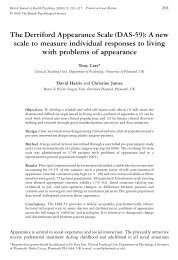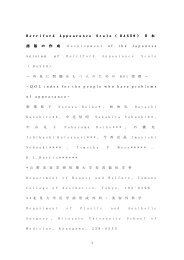DAS59 - Derriford Appearance Scales
DAS59 - Derriford Appearance Scales
DAS59 - Derriford Appearance Scales
You also want an ePaper? Increase the reach of your titles
YUMPU automatically turns print PDFs into web optimized ePapers that Google loves.
The <strong>Derriford</strong> <strong>Appearance</strong> Scale (<strong>DAS59</strong>) 221<br />
section was provided for respondents to add information<br />
that the scale might not cover but the overwhelming opinion<br />
was that the scale was comprehensive enough as it<br />
was. Considerable care has been taken to preserve the<br />
breadth of symptomatology during the refinement of the<br />
<strong>DAS59</strong>. Clinicians can be reassured that the problem<br />
focus of many items, whilst highly appropriate for respondents<br />
who are self-conscious of appearance, is of no<br />
concern to non-self-conscious respondents, who use the<br />
‘not applicable’ option.<br />
The <strong>DAS59</strong> is user-friendly, simple to administer and<br />
easy to score. The factorial structure enhances its sensitivity<br />
to change in condition after surgical and/or psychological<br />
treatment. It is now available for use in the adult clinical<br />
population (aged 16 years and over). It is not appropriate<br />
for children, who have unique requirements for self-report<br />
questionnaires in terms of item content, language and<br />
standardisation.<br />
The idea of using a psychometric scale in routine clinical<br />
practice is novel to most plastic surgeons. However,<br />
the benefits of doing so can be considerable 17 in terms of<br />
patient selection in both aesthetic plastic surgery and<br />
reconstructive plastic surgery and for the evaluation of<br />
outcome following treatment and in research.<br />
Patient selection in cosmetic surgery has traditionally<br />
centred upon surgical judgement of what can be done to<br />
enhance a given aspect of appearance together with an<br />
explanation to the patient of the limitations, consequences<br />
and risks of the operation proposed. If the patient consents,<br />
the surgeon usually agrees to carry out the surgery<br />
provided that he or she has no anxieties about the patient’s<br />
psychological health. An alternative approach would be to<br />
use the <strong>DAS59</strong> as an adjunct to the routine clinical interview<br />
to assess, objectively, the need for cosmetic surgery<br />
based on measured levels of psychological distress and<br />
dysfunction. From tables of normative data (e.g. Table 2, 3)<br />
the patient’s <strong>DAS59</strong> score(s) can be placed within the distributions<br />
of scores of other relevant groups such as those<br />
undergoing the same procedure. In general, the higher the<br />
score, the stronger the indication for treatment but, as<br />
paired preoperative and postoperative data accumulate, it<br />
should become possible to predict the odds for outcome<br />
based on preoperative scores. The <strong>DAS59</strong> can be administered<br />
at any stage before, during or after consultation. The<br />
scale’s high face validity reassures patients that their problems<br />
are understood, which helps to alleviate feelings of<br />
guilt. During consultation the scale’s items can also be a<br />
useful aide-mémoire for the clinician of the range of<br />
symptomatology.<br />
As with cosmetic surgery, current practice in patient<br />
selection for reconstructive plastic surgery tends to be<br />
centred on surgical assessment of the disfigurement or<br />
deformity with a recommendation to the patient as to<br />
what can be done and what ought to be done. In this<br />
process, the surgeon is intuitively influenced by the severity<br />
of the abnormality as he or she sees it rather than by<br />
the severity of the patient’s psychological reaction to that<br />
abnormality. The latter, which clearly is the more important,<br />
is measured by the <strong>DAS59</strong>. The scale’s introductory<br />
section will also identify which aspect of the patient’s<br />
abnormality causes most concern, thereby enabling the<br />
surgeon to focus on planning an operation that will give<br />
maximum relief from self-consciousness of appearance.<br />
Using the <strong>DAS59</strong>, the progress of patients undergoing<br />
multistage reconstructive surgery can be assessed, and<br />
treatments planned, with greater objectivity.<br />
The <strong>DAS59</strong> is a highly sensitive instrument with which<br />
to measure the effectiveness of reconstructive and cosmetic<br />
surgical interventions for appearance. It offers the potential<br />
to generate valid and reliable data for clinical audit and<br />
governance and to compare one operation or protocol for<br />
treatment against another: for example, to answer questions<br />
such as ‘which is the better method of breast reduction’ or<br />
‘how effective is cognitive therapy in improving life for<br />
patients with residual scarring’. As an objective measure of<br />
outcome, the <strong>DAS59</strong> can highlight those patients for whom<br />
treatment has been ineffective and, in reconstructive<br />
surgery, those patients who become psychologically distressed<br />
and dysfunctional in response to iatrogenic disfigurements<br />
(e.g. donor-site scarring and deformity). In the<br />
latter patients, the privacy of a self-report questionnaire<br />
can overcome the natural reservations of some patients to<br />
complain for fear of upsetting or offending their surgeons.<br />
In research, the <strong>DAS59</strong> will be highly valuable as an<br />
instrument with which to investigate new treatment protocols<br />
that combine plastic surgical interventions and<br />
psychological interventions such as cognitive behavioural<br />
therapies. It may help to answer questions of theoretical<br />
interest in psychological aspects of problems to do with<br />
appearance. For example, the development of the scale<br />
has revealed the possibility that self-consciousness of<br />
appearance is a psychological dimension distributed<br />
throughout the general population, from which the clinical<br />
population self-selects, at least in part, by virtue of<br />
the high levels of psychological distress and dysfunction<br />
that are associated with their self-consciousness of<br />
appearance. 18 Clarification of the importance of appearance<br />
to successful psychological functioning and wellbeing<br />
is necessary if politicians, managers and others<br />
who influence the allocation of resources for plastic surgical<br />
and psychological services are to recognise the full<br />
clinical needs of patients who are self-conscious of<br />
disfigurements and aesthetic problems of appearance. 25<br />
Acknowledgements<br />
We thank the British Association of Plastic Surgeons, the Polytechnics<br />
and Colleges Funding Council, the Department of Health, the South<br />
West Regional Health Authority, the South and West Devon Health<br />
Authority, the Head and Neck Directorate, Plymouth Hospitals NHS<br />
Trust and the Torbay Research and Education Fund for funding various<br />
parts of the work upon which this paper is based. We also thank Jan<br />
Collis, Stella Barton, Rona Slator, Tim Moss and Christine James for<br />
their assistance at different stages of the project.<br />
References<br />
1. Macgregor FC. Social, psychological and cultural dimensions of<br />
cosmetic and reconstructive plastic surgery. Aesthetic Plast Surg<br />
1989; 13: 1–8.<br />
2. Fee-Fulkerson K, Conaway MR, Winer EP, Fulkerson CC, Rimer BK,<br />
Georgiade G. Factors contributing to patient satisfaction with<br />
breast reconstruction using silicone gel implants. Plast Reconstr<br />
Surg 1996; 97: 1420–6.<br />
3. Ward CM. Rationing and resource management. Br J Plast Surg<br />
1994; 47: 162–6.





